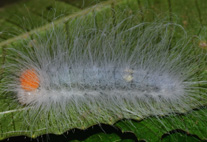Abstract
Last instar larvae and pupae of Ourocnemis archytas (Lepidoptera: Riodinidae) are described for the first time and compared with those of Anteros formosus, which are also described in detail. Last instars of both species present body covered with long white plumose setae, a row of orange balloon setae on the prothoracic shield, and clusters of perforated cupola organs (PCOs) near the spiracles; differences are the black cephalic capsule, the placement and format of balloon setae cluster, and the presence of enlarged black tips on some plumose setae. Pupae of O. archytas resemble that of Anteros, covered with the last instar setae and with no balloon setae. Characteristics of the immature stages of these two genera could be useful to establish the still unresolved relationship between them. A summary of the host plants of Helicopini is presented, showing a polyphagous pattern for Anteros, recorded in 21 host plant families, which contrasts with the specialized diet observed in Helicopis and Sarota.

